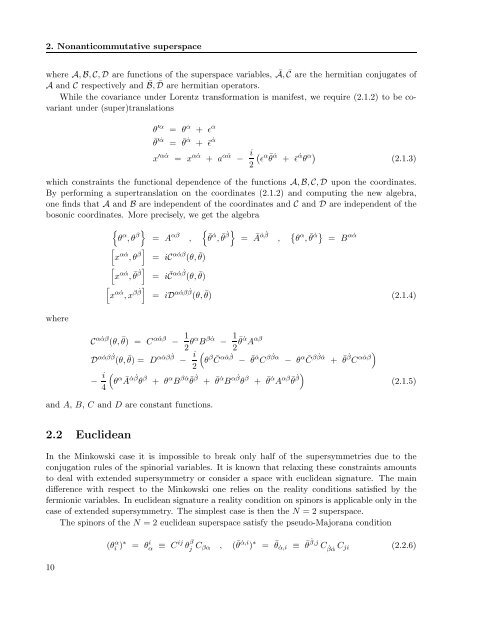Perturbative and non-perturbative infrared behavior of ...
Perturbative and non-perturbative infrared behavior of ...
Perturbative and non-perturbative infrared behavior of ...
Create successful ePaper yourself
Turn your PDF publications into a flip-book with our unique Google optimized e-Paper software.
2. Nonanticommutative superspace<br />
where A, B, C, D are functions <strong>of</strong> the superspace variables, Ā, ¯ C are the hermitian conjugates <strong>of</strong><br />
A <strong>and</strong> C respectively <strong>and</strong> ¯ B, ¯ D are hermitian operators.<br />
While the covariance under Lorentz transformation is manifest, we require (2.1.2) to be covariant<br />
under (super)translations<br />
θ ′α = θ α + ǫ α<br />
¯θ ′ ˙α = ¯ θ ˙α + ¯ǫ ˙α<br />
x ′α ˙α = x α ˙α + a α ˙α − i<br />
2<br />
ǫ α¯ θ ˙α + ¯ǫ ˙α θ α <br />
(2.1.3)<br />
which constraints the functional dependence <strong>of</strong> the functions A, B, C, D upon the coordinates.<br />
By performing a supertranslation on the coordinates (2.1.2) <strong>and</strong> computing the new algebra,<br />
one finds that A <strong>and</strong> B are independent <strong>of</strong> the coordinates <strong>and</strong> C <strong>and</strong> D are independent <strong>of</strong> the<br />
bosonic coordinates. More precisely, we get the algebra<br />
where<br />
<br />
θ α ,θ β<br />
<br />
x α ˙α ,θ β<br />
<br />
x α ˙α , ¯ θ ˙ β <br />
<br />
x α ˙α ,x β ˙ β <br />
= A αβ<br />
= iC α ˙αβ (θ, ¯ θ)<br />
= i ¯ C α ˙α ˙ β (θ, ¯ θ)<br />
,<br />
¯θ ˙α , ¯ θ ˙ β <br />
= Ā ˙α ˙ β<br />
, θ α , ¯ θ ˙α α ˙α<br />
= B<br />
= iD α ˙αβ ˙ β (θ, ¯ θ) (2.1.4)<br />
C α ˙αβ (θ, ¯ θ) = C α ˙αβ − 1<br />
2 θαB β ˙α − 1<br />
2 ¯ θ ˙α A αβ<br />
D α ˙αβ ˙ β<br />
(θ, θ) ¯ α ˙αβ<br />
= D ˙ β i<br />
−<br />
− i<br />
4<br />
2<br />
<br />
θ β ¯ C α ˙α ˙ β − ¯ θ ˙α C β ˙ βα − θ α ¯ C β ˙ β ˙α + ¯ θ ˙ βC α ˙αβ <br />
<br />
θ α Ā ˙α ˙ β θ β + θ α B β ˙α¯ θ ˙ β + ¯ θ ˙α B α ˙ β θ β + ¯ θ ˙α A αβ ¯ θ ˙ β <br />
<strong>and</strong> A, B, C <strong>and</strong> D are constant functions.<br />
2.2 Euclidean<br />
(2.1.5)<br />
In the Minkowski case it is impossible to break only half <strong>of</strong> the supersymmetries due to the<br />
conjugation rules <strong>of</strong> the spinorial variables. It is known that relaxing these constraints amounts<br />
to deal with extended supersymmetry or consider a space with euclidean signature. The main<br />
difference with respect to the Minkowski one relies on the reality conditions satisfied by the<br />
fermionic variables. In euclidean signature a reality condition on spinors is applicable only in the<br />
case <strong>of</strong> extended supersymmetry. The simplest case is then the N = 2 superspace.<br />
The spinors <strong>of</strong> the N = 2 euclidean superspace satisfy the pseudo-Majorana condition<br />
10<br />
(θ α i )∗ = θ i α ≡ Cij θ β<br />
j Cβα , ( ¯ θ ˙α,i ) ∗ = ¯ θ ˙α,i ≡ ¯ θ ˙ β,j C ˙ β ˙α Cji (2.2.6)
















